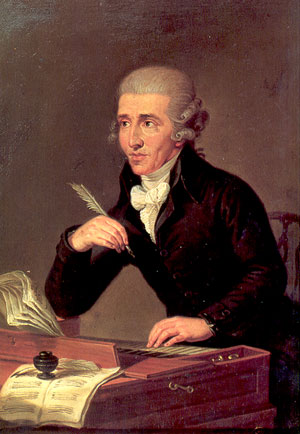Joseph Haydn (1732-1809)
Born March 31, 1732 in Rohrau Austria.
Died May 31, 1809 in Vienna Austria.
Cello Concerto No. 2 in D major Hob. VIIb:2 (Op. 101)
Composed 1783 at the Esterházy mansion.
First Performance: Unknown. Antonin Kraft as soloist, perhaps in Frankfurt-am-Main.
Instrumentation: 2 oboes, 2 horns and strings.
Joseph Haydn spent many years (1762-1790) in the service of the Esterházy family as composer and Kapellmeister. This concerto was composed specifically for Antonin Kraft who was a cellist in the Esterházy orchestra. For a time it was believed by some scholars (Donald Francis Tovey no less) that this concerto was composed by Kraft and not Haydn. There is much evidence to the contrary. The score in Haydn’s handwriting bearing the date 1783 was in existence until the mid nineteenth century. (It has since been lost). It appeared in a thematic catalog of his works which was compiled under his supervision in 1805. Certainly Kraft advised Haydn on questions of technique as Joachim did for Brahms.
The concerto is in three movements.
I Allegro moderato
II Adagio
III Rondo (Allegro)
The sonata allegro first movement opens with the violins playing the first theme. It is then repeated with the addition of the winds.
Example 1. Opening theme
There is a brief bridge passage which then leads to the second theme played by the violins.
Example 2. Second theme
The soloist then enters with the opening theme over a subdued background. The theme repeats with embellishments by the soloist until the second theme is quietly taken up by the soloist. We then hear the soloist flying off into bravura passagework. There is a cadenza and the movement ends with a reiteration of the first theme by the winds.
In the adagio second movement the soloist introduces the main theme.
Example 3. Second movement
There is a brief tutti after which the soloist reenters with an expansion of the second part of the main theme. The remainder of this brief movement features simple variations on this and a cadenza.
The third movement Rondo (allegro), begins with the rondo theme (the theme that keeps reappearing) played by the soloist. More than one British writer as compared this theme with the tune “Here we go gathering nuts in May”. This theme is then repeated tutti.
Example 4. Third Movement rondo theme
A contrasting second theme is then introduced by the soloist.
Example 5. Second theme
The first theme then reappears – it is a rondo after all followed by the soloist playing final theme which is in the same vein as the first theme.
Example 6. Final theme
In the coda the first theme regains prominence to bring the work to its conclusion. There is much give and take between the soloist and orchestra which perhaps caused H.C. Robbins Landon to describe this movement as being “full of virtuoso passages fascinating to the soloists and painful to the listener.”
Resources
[amazon template=iframe image&asin=B0000025J3][amazon template=iframe image&asin=B003FBFBG4]
There is a public domain score at IMSLP / Petrucci Music Library
[amazon template=iframe image&asin=0500011680]






